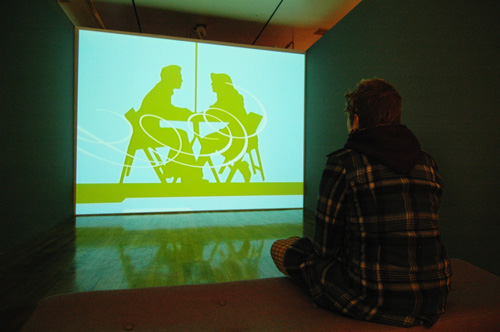Exhibit explores pervasiveness of brand names
February 7, 2007
In a world filled with brands and logos, it is hard to walk through the Quad without being smacked in the face by brand names. Hollister, North Face and Nike are just some of the brands that are prevalent among the sea of students traveling to class. It is no wonder in a culture so defined by possessions and appearance that artists take notice.
Judith Fox, visiting curator for Krannert Art Museum’s “Branded and on Display” art exhibit, said this exhibit explores the artists’ rendition of our society’s dependence on brand names by integrating them subtly into their work.
“These days, there are artists whose works are reflective and a commentary on the world in which we live,” Fox said. “This is the first expedition that I know of that deals with questions of branding and display tactics.”
As a society we brand ourselves, Fox said.
She said what we choose to wear is a reflection of who we are, and we choose the brands we do because there is something about them we want reflected in us.
Get The Daily Illini in your inbox!
We use brands to identify ourselves.
In one piece, by Ai Weiwei, a Coca-Cola logo has been painted on a Neolithic Pot.
“I think of it as a reflection of what is history, or culture, and now it’s coded with an emblem,” Fox said. “What is that telling us about the world in which we live?”
This pot may be thought of as a response to the pervasiveness of certain brands – that they reach as far as our history does – or it can be seen as just a painted pot.
Whichever interpretation is right is up to the viewer.
“Whether you look at this exhibit as ironic or celebratory, most of the work in this show doesn’t take a political, moral or ethical kind of point of view,” Fox said. “I want to leave it open-ended, to call to people’s attention this is the world we live in. We must live in a conscious way if we’re going to spend most of our waking hours advertising.”
Even animals can be used to portray certain aspects of our culture.
In a serious of five paintings, artist Laurie Hogin explores how animals can be used to portray products, including I Can’t Believe It’s Not Butter, Colgate toothpaste and Starbucks.
Diane Schumacher, director of marketing for the Krannert Art Museum, said this exhibit is making people re-evaluate the world they live in.
“I think a lot of it is just making us more aware,” Schumacher said. “It’s asking us to review at what’s around us, to look at everything, even what we take for granted.”
Take the Kodak moment. It is supposed to be a genuine moment, filled with love and memories.
Instead it is a fake, staged act with complete strangers.
Even something as simple as a photograph, something that immortalizes a specific moment in time, may be commercialized.
Artist Amy Barkow made a revelation: If a picture is held up to the light, it can be seen through. The integrity of the picture remains, but there is now a brand pervading the original image.
“The photograph is revealing someone’s personal life, but it is made corporate now,” Fox said. “It is now the opposite of the Kodak moment, which are fake. This is honestly real, but it has become corporate.”
In China, artist Zhao Bandi shows that not all branding is bad and tries to make corporate messages personal.
Through this role reversal, he attempts to make the public health announcements more accessible by a panda used in his work.
Fox said this panda brings a more emotional connotation to the message than a plain banner does. Through this it has a more immediate and personal meaning.
This meaning can be understood across boundaries. In fact, many logos are universal symbols of a product, such as the Nike Swoosh.
In a black-and-white photograph of a man by Hank Willis Thomas, there is nothing but a Swoosh on his head. It is simple enough and can be taken in many ways – advertising or the ever-present “Just Do It” campaign, for example. Or it can be seen as Nike’s influence over our culture to such a degree that it has become a part of our being, part of our body.
Nike has become a part of what defines us.
Yet, as a school, the students have found another way to brand themselves. Walking into the Assembly Hall during a basketball game is like walking into a sea of orange. Students dress up and identify with each other, both as students and as fans.
Amelia Moore, senior in FAA and Daily Illini photographer, explores the sea of orange in her photograph “Children of the Corn.”
“What could be more branded then everyone dressing in the color and clothing of their school?” Fox asked.
Whether being identified by brand names is a good thing is still to be determined.
However, this exhibit allows students to view their culture and other various cultures objectively, Fox said.
Schumacher said she feels that the exhibit doesn’t have to pose deep questions if a person doesn’t want it to; it can just be fun.
“It’s exciting, it’s different, and I think that they’re going to see something that they’ve never seen before,” Schumacher said.
The works of these artists and others can be seen through April 1.







